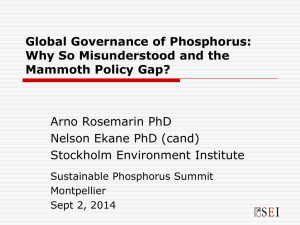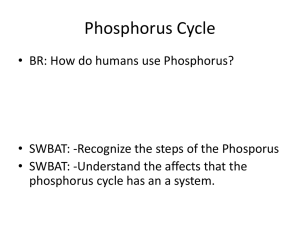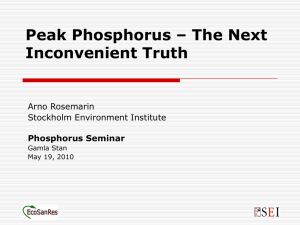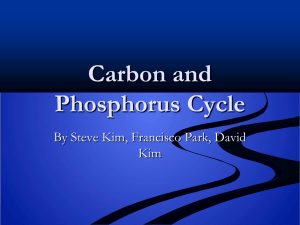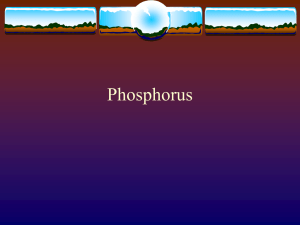Phosphorus Measurements
advertisement
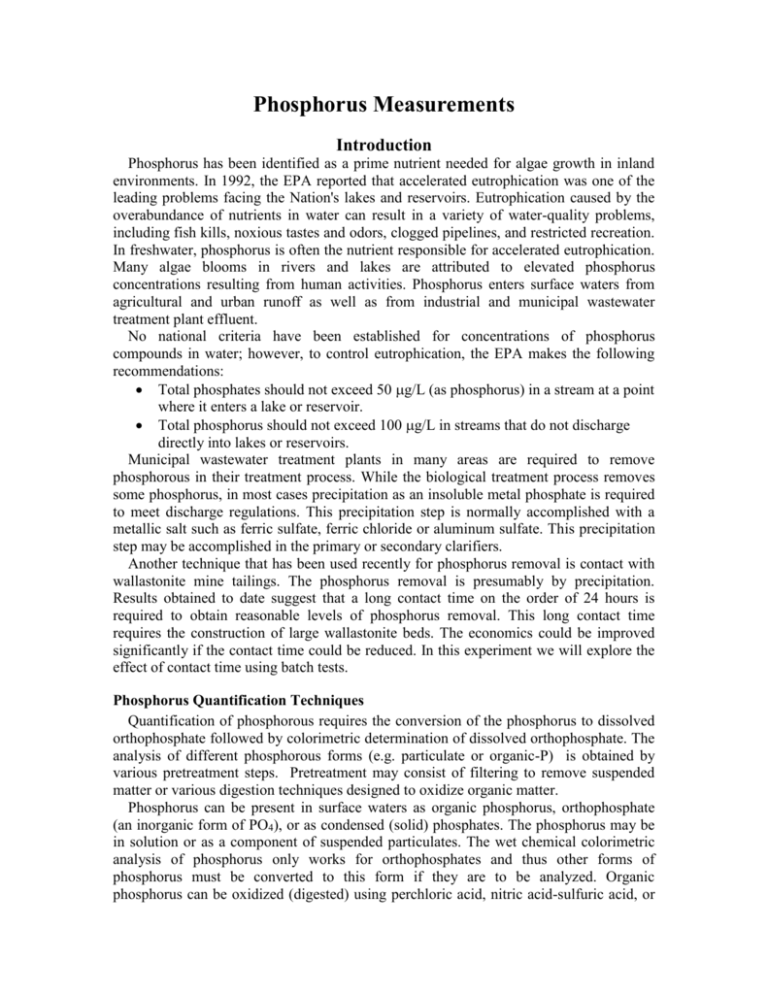
Phosphorus Measurements Introduction Phosphorus has been identified as a prime nutrient needed for algae growth in inland environments. In 1992, the EPA reported that accelerated eutrophication was one of the leading problems facing the Nation's lakes and reservoirs. Eutrophication caused by the overabundance of nutrients in water can result in a variety of water-quality problems, including fish kills, noxious tastes and odors, clogged pipelines, and restricted recreation. In freshwater, phosphorus is often the nutrient responsible for accelerated eutrophication. Many algae blooms in rivers and lakes are attributed to elevated phosphorus concentrations resulting from human activities. Phosphorus enters surface waters from agricultural and urban runoff as well as from industrial and municipal wastewater treatment plant effluent. No national criteria have been established for concentrations of phosphorus compounds in water; however, to control eutrophication, the EPA makes the following recommendations: Total phosphates should not exceed 50 g/L (as phosphorus) in a stream at a point where it enters a lake or reservoir. Total phosphorus should not exceed 100 g/L in streams that do not discharge directly into lakes or reservoirs. Municipal wastewater treatment plants in many areas are required to remove phosphorous in their treatment process. While the biological treatment process removes some phosphorus, in most cases precipitation as an insoluble metal phosphate is required to meet discharge regulations. This precipitation step is normally accomplished with a metallic salt such as ferric sulfate, ferric chloride or aluminum sulfate. This precipitation step may be accomplished in the primary or secondary clarifiers. Another technique that has been used recently for phosphorus removal is contact with wallastonite mine tailings. The phosphorus removal is presumably by precipitation. Results obtained to date suggest that a long contact time on the order of 24 hours is required to obtain reasonable levels of phosphorus removal. This long contact time requires the construction of large wallastonite beds. The economics could be improved significantly if the contact time could be reduced. In this experiment we will explore the effect of contact time using batch tests. Phosphorus Quantification Techniques Quantification of phosphorous requires the conversion of the phosphorus to dissolved orthophosphate followed by colorimetric determination of dissolved orthophosphate. The analysis of different phosphorous forms (e.g. particulate or organic-P) is obtained by various pretreatment steps. Pretreatment may consist of filtering to remove suspended matter or various digestion techniques designed to oxidize organic matter. Phosphorus can be present in surface waters as organic phosphorus, orthophosphate (an inorganic form of PO4), or as condensed (solid) phosphates. The phosphorus may be in solution or as a component of suspended particulates. The wet chemical colorimetric analysis of phosphorus only works for orthophosphates and thus other forms of phosphorus must be converted to this form if they are to be analyzed. Organic phosphorus can be oxidized (digested) using perchloric acid, nitric acid-sulfuric acid, or persulfate with the persulfate technique being the safest and least time consuming. The digestion methods are detailed in APHA method 4500-P B. Three techniques for colorimetric analysis of phosphorus are available. The technique most commonly used is the ascorbic acid method, which can determine concentrations of orthophosphate in most waters and wastewater in the range from 2-200 g P/L. Ammonium molybdate and antimony potassium tartrate react in an acid medium with dilute solutions of orthophosphate-phosphorus to form an intensely colored antimonyphospho-molybdate complex. This complex is reduced to an intensely blue-colored complex by ascorbic acid. The color is proportional to the phosphorus concentration. The complex is not stable and thus analysis must be performed within 30 minutes of adding the ammonium molybdate and antimony potassium tartrate. Barium, lead, and silver interfere by forming a precipitate. The interference from silica, which forms a pale-blue complex is small and can usually be considered negligible. Arsenate is determined similarly to phosphorus and should be considered when present in concentrations higher than phosphorus. Method Detection Limit "Method detection limit" is the smallest concentration that can be detected above the noise in a procedure and within a stated confidence level. Several types of detection limits are used including instrument detection limit (IDL), method detection limit (MDL), and practical quantitation limit (PQL). The IDL is strictly instrument noise and does not include variability due to sample preparation steps. The MDL includes both instrument noise and sample preparation variability. The MDL is obtained by making a standard that is near the MDL and dividing it into at least 7 portions. Each of the portions is then processed through all sample preparation steps and then analyzed. The MDL is calculated using the following equation. MDL stn 1, 1.1 where n is the sample size and =0.01 is generally the required confidence. The student t distribution function is available in Excel as a two sided test statistic (so use TINV(2,n1)) and the standard deviation, s, can be computed in Excel as STDEV(). The PQL is about five times the MDL and represents a practical and routinely achievable detection limit with reasonable assurance that any reported value greater than the PQL is reliable. According to Standard Methods the method detection limit for phosphorus when using a 1 cm light path is approximately 150 g P/L. Spectrophotometer Limitations The diode array spectrophotometer has 316 diodes that cover the wavelength range of 190 nm to 820 nm. Each diode generates a voltage output that is proportional to the number of incident photons. The voltage is then digitized, but the manufacturer of the instrument in the Cornell Environmental Laboratory, Hewlett-Packard, doesn't report the resolution of the analog to digital converter. At very low concentrations the difference between the intensity of light transmitted through the reference and the intensity of light transmitted through the sample approaches zero. At some low concentration the difference in light intensity approaches the resolution of the analog to digital converter. Another source of instrument error is drift in lamp intensity over time. The lamp intensity is measured when a reference sample is made. The light intensity recorded by the diodes will vary proportionally to any lamp intensity drift. The IDL should decrease as the number of diodes used in the analysis increases (as in Spectral analysis) for the same reason that replicate analysis of samples decreases the standard deviation. The "Spectral analysis" feature, which can be used to measure either single or multiple components, uses as much of the spectrum as the user desires and thus potentially decreases the IDL. Spectral analysis uses general least squares regression to add multiples of extinction coefficient arrays for each component to obtain the best curve fit for the sample. The extinction coefficient arrays are obtained from the slope of the linear regression line for absorbance as a function of concentration at each wavelength. Experimental Objectives 1) Measure the concentration of phosphorus in several samples to test the precision of the ascorbic acid technique. 2) Analyze the data using spectrophotometer software outside the lab. 3) Analyze multiple samples so that confidence intervals can be calculated. 4) Estimate the method detection limit (MDL). 5) Discuss methods to improve the method detection limit. 6) Compare the results obtained using conventional analysis at a single wavelength with spectral analysis. Experimental Procedures Standards Preparation Method 1) Use 100 g P/L stock. 2) Use a digital pipet and prepare 1 mL of each standard. 3) Use E-pure water to dilute the 100 g P/L stock. Reagent Addition for Samples and Standards 1) Pipette 1 mL sample into a disposable microcuvet using a 1 mL digital pipette. 2) Add 160 L combined reagent and mix thoroughly by swirling. 3) After at least 10 minutes but no more than 30 minutes, measure absorbance of each sample using a reagent blank as the reference solution. Samples and Standards to Prepare 1) Reagent blank to be used as reference samples. 2) Prepare 6 standards containing 0 (reagent blank), 1, 3, 10, 30, 100 g P/L. 3) Prepare 6 additional 10 g P/L standards. 4) Prepare samples Spectrophotometer Method 1) Use Sample Cuvettes. (Make sure to orient all cuvettes with the arrow on the left because the cuvettes are not symmetrical and have different absorbance when turned 180.) 2) Use the reagent blank as the reference sample for all samples. 3) Use units of g P/L. 4) Fill in the general description (in the spectrophotometer software) with your NetID and a description of the type of samples. Samples Analysis 1) Measure the reference using a reagent blank. (The reagent blank is also the 0 mg/L standard.) 2) Analyze the reagent blank as a sample and verify that the absorbance deviates less than 0.004 AU (absorbance units) from zero. If the absorbance deviates more than 0.004 AU reanalyze the reference sample. 3) Analyze 6 standards as standards using the spectrophotometer and save the data as \\Enviro\enviro\Courses\453\phosphorus\netid_Pstd. 4) Analyze 6 standards as samples using the spectrophotometer and save the data as \\Enviro\enviro\Courses\453\phosphorus\netid_Pstdsam. 5) Analyze 7 10-g P/L standards as samples and save the data as \\Enviro\enviro\Courses\453\phosphorus\netid_10Pstdsam. 6) Analyze wallastonite samples as samples using the spectrophotometer and save the data as \\Enviro\enviro\Courses\453\phosphorus\netid_wall. 7) After you have analyzed all of your samples use the computer at your workstation to export each of the data files. You will need to use the Spectrophotometer software and load each of the files in turn and then use the export function. Save the files using the same naming convention as before, but use “exp” as the last 3 letters in the name. Prelab Questions 1) You will be creating 1 mL standards by diluting a stock of 100 g P/L. Create a table showing how you will prepare 1 mL of each of the standards using only pipettes. 2) All of the samples including standards are diluted with a small amount of combined reagent. How is this dilution accounted for when calculating the concentration of samples? Data Analysis 1) Plot the absorbance spectra of the standards. 2) Choose an appropriate wavelength (perhaps an absorbance peak) and use Excel to create a calibration curve. For the calibration curve, absorbance should be a function of phosphorus concentration. 3) Use the 10-g/L standards that were analyzed as samples to evaluate the Method Detection Limit using single wavelength analysis. Use your Spreadsheet to calculate the concentration of each of the replicates. 4) Create a plot showing phosphorus remaining as a function of time and wallastonite dose. Report the wallastonite dose in g/L. Spreadsheet requirements Your spreadsheet must contain all of the analysis requested above as well as the following capabilities: 1) A well-marked cell containing the analytical wavelength for single wavelength analysis. Changes to this cell must be reflected in all calculations and graphs. 2) The graph showing the absorbance spectra of the standards must have a vertical line indicating the analytical wavelength. 3) All of the graphs must be on the same page as the analytical wavelength control so the effect of changing the wavelength can be easily observed. 4) A separate sheet where you answer the questions below. Hints If you haven't already learned how to use Vlookup() now is the time! The row() function returns the number of the row. I found it useful for this analysis! The slope() and intercept() functions eliminate the need to type equations off of graphs! Questions 1) What is happening in the UV region? 2) Are there any absorbance peaks? 3) Total phosphorus concentration in Cayuga Lake varies between 10 and 50 ppb. Would the techniques used in this lab be able to measure these phosphorus levels? 4) What did you learn about the effect of time and wallastonite concentration on phosphorus removal? References http://wwwrvares.er.usgs.gov/nawqa/circ-1136/h6.html#PHOS http://www.epa.gov/glnpo/lmmb/methods/index.html#Volume 3 Standard Methods for the Examination of Water and Wastewater. Lab Prep Notes Reagents A Sulfuric acid solution, 4.9 N: Add 136 mL concentrated H2SO4 to 800 mL E-pure water. Cool and dilute to 1 L with E-pure water. B Ammonium molybdate solution: Dissolve 40 g of (NH4 )6 Mo7O24•4H2O in 900 mL E-pure water and dilute to 1 L. Store at 4°C. C Ascorbic acid: Dissolve 9 g of ascorbic acid (C6H8O6) in 400 mL Epure water and dilute to 500 mL. Store at 4°C. Keep well stoppered. Prepare fresh monthly or as needed. D Antimony potassium tartrate: Dissolve 3.0 g of K(SbO)C4H4O6•½H2O in 800 mL Epure water and dilute to 1 L. Store at 4°C. Combined color reagent: Combine the following solutions in order, mixing (but do not entrain air as Table 1-1. Reagents Description Supplier concentrated H2SO4 (NH4 )6 Mo7O24•4H2O C6H8O6 K(SbO)C4H4O6• ½H2O sodium lauryl sulfate KH2PO4 Fisher Scientific Table 1-2. Catalog number Fisher Scientific Fisher Scientific Fisher Scientific Fisher Scientific Equipment list Description Supplier 100-1095 µL Fisher Scientific pipette 10-109.5 µL pipette Fisher Scientific Disposable cuvets Fisher Scientific Cuvet holder Fisher Scientific UV-Vis Hewlett-Packard spectrophotometer Company Catalog # 13-707-5 13-707-3 14-385-942 14-385-939 8452A oxygen oxidizes the ascorbic acid) after each addition: (Prepare fresh weekly. Store at 4°C) Stock A, (4.9 N H2SO4) 50 mL Stock B, (Ammonium molybdate solution) 15 mL Stock C, (Ascorbic acid solution) 30 mL Stock D, (Antimony-tartrate solution) 5 mL Water diluent solution: Add 4.0 g sodium lauryl sulfate and 5 g NaCl per L of E-pure water. Stock phosphorus standard: Dissolve 0.4394 g of Potassium phosphate monobasic (KH2PO4) (dried at 105°C for one hour) in 900 mL E-pure water. Add 2 mL of concentrated H2SO4 and dilute to 1 L. 1.0 mL = 0.100 mg P (100 mg P/L). Rinse reagent containers with the mixed reagent and then with E-pure water to allow the reagent to react with all the phosphorus in the containers.


